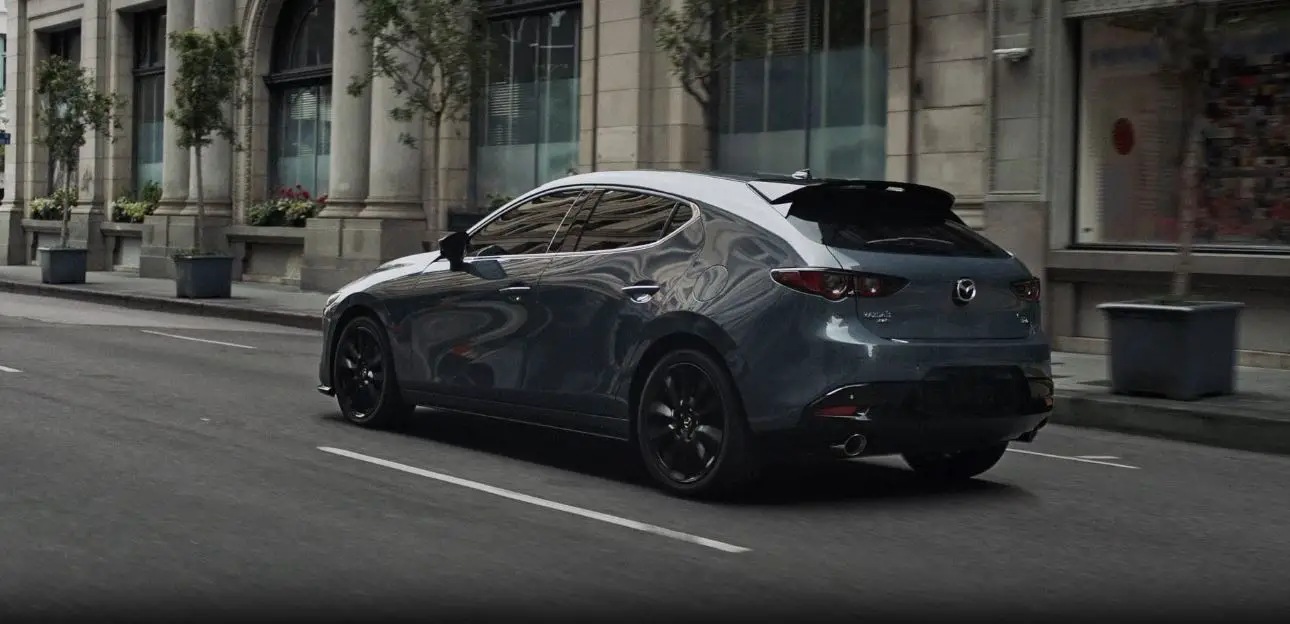Mazda 3 Hatchback 2023 Forward Sensing Camera (FSC) User Manual
Introduction
A well-known and fashionable compact car that blends performance, style, and cutting-edge technology is the Mazda 3 Hatchback 2023. The forward-sensing camera system is one of the Mazda 3 Hatchback’s standout features. This ground-breaking technology increases security and offers a variety of cutting-edge driver-aid capabilities. The vehicle’s front-mounted forward-sensing camera combines cutting-edge image processing and recognition tools to keep an eye on the road ahead. It records and processes visual input, enabling the vehicle to respond intelligently to diverse driving circumstances. The Mazda 3 Hatchback’s Smart Brake Support system can be activated, which is one of the front sensing camera’s main uses.
This system can detect and keep an eye on any vehicles or people in front of the automobile, and if it senses a potential collision, it will instantly apply the brakes. By adding an extra layer of protection, it aids in reducing or even preventing accidents. The Mazda 3 Hatchback’s forward-sensing camera also supports additional cutting-edge driver assistance functions. These include Adaptive Cruise Control, which maintains a safe following distance from the vehicle in front and modifies the speed accordingly, and Lane-Keep Assist, which aids the driver in staying inside the lane by offering steering assistance if the car starts to drift accidentally.
Forward Sensing Camera (FSC)
Forward Sensing Camera (FSC) Your vehicle is equipped with a Forward Sensing Camera (FSC). The Forward Sensing Camera (FSC) is positioned near the rearview mirror and used by the following systems.
- High Beam Control System (HBC) Lane Departure Warning System (LDWS) Traffic Sign Recognition System (TSR) Distance & Speed Alert (DSA) Driver Attention Alert (DAA) Mazda Radar Cruise Control (MRCC) Mazda Radar Cruise Control with Stop & Go function (MRCC with Stop & Go function) Lane-keep Assist System (LAS) Traffic Jam Assist (TJA) Smart Brake Support (SBS) forward drive detection
 Forward Sensing Camera (FSC)
Forward Sensing Camera (FSC)
The Forward Sensing Camera (FSC) determines the conditions ahead of the vehicle while traveling at night and detects traffic lanes. The distance in which the Forward Sensing Camera (FSC) can detect objects varies depending on the surrounding conditions.
WARNING
Do not modify the suspension:
If the vehicle height or inclination is changed, the system will not be able to correctly detect vehicles ahead. This will result in the system not operating normally or mistakenly operating, which could cause a serious accident.
CAUTION
- Do not apply accessories, stickers or film to the windshield near the Forward Sensing Camera (FSC). If the area in front of the Forward Sensing Camera (FSC) lens is obstructed, it will cause the system to not operate correctly. Consequently, each system may not operate normally which could lead to an unexpected accident. Do not disassemble or modify the Forward Sensing Camera (FSC). Disassembly or modification of the Forward Sensing Camera (FSC) will cause a malfunction or mistaken operation. Consequently, each system may not operate normally which could lead to an unexpected accident. Heed the following cautions to assure the correct operation of the Forward Sensing Camera (FSC). Be careful not to scratch the Forward Sensing Camera (FSC) lens or allow it to get dirty.
- Do not remove the Forward Sensing Camera (FSC) cover. Do not place objects on the dashboard that reflect light. Always keep the windshield glass around the camera clean by removing dirt or fogging. Use the windshield defroster to remove fogging on the windshield. Consult an Authorized Mazda Dealer regarding cleaning the interior side of the windshield around the Forward Sensing Camera (FSC). Consult an Authorized Mazda Dealer before performing repairs around the Forward Sensing Camera (FSC). The Forward Sensing Camera (FSC) is installed to the windshield. Consult an Authorized Mazda Dealer for windshield repair and replacement. When cleaning the windshield, do not allow glass cleaners or similar cleaning fluids to get on the Forward Sensing Camera (FSC) lens. In addition, do not touch the Forward Sensing Camera (FSC) lens. When performing repairs around the rearview mirror, consult an Authorized Mazda Dealer. Consult an Authorized Mazda Dealer regarding cleaning of the camera lens. Do not hit or apply strong force to the Forward Sensing Camera (FSC) or the area around it. If the Forward Sensing Camera (FSC) is severely hit or if there are cracks or damage caused by gravel or debris in the area around it, stop using the following systems and consult an Authorized Mazda Dealer.
- High Beam Control System (HBC) Lane Departure Warning System (LDWS) Traffic Sign Recognition System (TSR) Distance & Speed Alert (DSA) Driver Attention Alert (DAA) Mazda Radar Cruise Control (MRCC) Mazda Radar Cruise Control with Stop & Go function (MRCC with Stop & Go function) Lane-keep Assist System (LAS) Traffic Jam Assist (TJA) Smart Brake Support (SBS) forward drive detection
- The direction in which the Forward Sensing Camera (FSC) is pointed has been finely adjusted. Do not change the installation position of the Forward Sensing Camera (FSC) or remove it. Otherwise, it could result in damage or malfunction.
- Always use tires for all wheels that are of the specified size, and the same manufacturer, brand, and tread pattern. In addition, do not use tires with significantly different wear patterns on the same vehicle as the system may not operate normally. The Forward Sensing Camera (FSC) includes a function for detecting a soiled windshield and informing the driver, however, depending on the conditions, it may not detect plastic shopping bags, ice, or snow on the windshield. In such cases, the system cannot accurately determine a vehicle ahead and may not be able to operate normally. Always drive carefully and pay attention to the road ahead.
NOTE
- In the following cases, the Forward Sensing Camera (FSC) cannot detect target objects correctly, and each system may be unable to operate normally. The height of the vehicle ahead is low. You drive your vehicle at the same speed as the vehicle ahead. Headlights are not turned on during the night or when going through a tunnel. In the following cases, the Forward Sensing Camera (FSC) may not be able to detect target objects correctly. Under bad weather conditions, such as rain, fog, and snow.
- The window washer is being used or the windshield wipers are not used when it’s raining.
- Ice, fog, snow, frost, rainfall, dirt, or foreign matter such as a plastic bag is stuck on the windshield. Trucks with low loading platforms and vehicles with an extremely low or high profile.
- When driving next to walls with no patterning (including fences and longitudinally striped walls). The taillights of the vehicle ahead are turned off.
- A vehicle is outside the illumination range of the headlights. The vehicle is making a sharp turn, or ascending or descending a steep slope. Entering or exiting a tunnel. Heavy luggage is loaded causing the vehicle to tilt.
- Strong light is shone at the front of the vehicle (backlight or high-beam light from on-coming vehicles). There are many light emitters on the vehicle ahead. When the vehicle ahead is not equipped with taillights or the taillights are turned off at nighttime. Elongated luggage or cargo is loaded onto installed roof rails and covers the Forward Sensing Camera (FSC). Exhaust gas from the vehicle in front, sand, snow, and water vapor rising from manholes and grating, and water splashed into the air.
- When towing a malfunctioning vehicle.
- The vehicle is driven with tires having significantly different wear.
- The vehicle is driven on down slopes or bumpy roads. There are water puddles on the road.
- The surroundings are dark such as during the night, early evening, or early morning, or in a tunnel or indoor parking lot.
- The illumination brightness of the headlights is reduced or the headlight illumination is weakened due to dirt or a deviated optical axis. The target object enters the blind spot of the Forward Sensing Camera (FSC). A person or object bursts onto the road from the shoulder or cuts right in front of you.
- You change lanes and approach a vehicle ahead.
- When driving extremely close to the target object.
- Tire chains or a temporary spare tire is installed. The vehicle ahead has a special shape. For example, a vehicle towing a trailer house or a boat, or a vehicle carrier carrying a vehicle with its front pointed rearward.
- If the Forward Sensing Camera (FSC) cannot operate normally due to rain, backlight, or fog, the system functions related to the Forward Sensing Camera (FSC) are temporarily stopped and the following warning lights turn on. However, this does not indicate a malfunction. High Beam Control System (HBC) warning indication/warning light (amber) i-ACTIVSENSE warning indication/warning light If the Forward Sensing Camera (FSC) cannot operate normally due to high temperatures, the system functions related to the Forward Sensing Camera (FSC) are temporarily stopped and the following warning lights turn on. However, this does not indicate a malfunction. Cool down the area around the Forward Sensing Camera (FSC) such as by turning on the air conditioner. High Beam Control System (HBC) warning indication/warning light (amber) i-ACTIVSENSE warning indication/warning light
- If the Forward Sensing Camera (FSC) detects that the windshield is dirty or foggy, the system functions related to the Forward Sensing Camera (FSC) are temporarily stopped and the following warning lights turn on. However, this does not indicate a problem. Remove the dirt from the windshield or press the defroster switch and defog the windshield. High Beam Control System (HBC) warning indication/warning light (amber) i-ACTIVSENSE warning indication/warning light If there are recognizable cracks or damage caused by flying gravel or debris on the windshield, always have the windshield replaced. Consult an Authorized Mazda Dealer for replacement.
- The Forward Sensing Camera (FSC) recognizes pedestrians when all of the following conditions are met:
The height of a pedestrian is about 1 to 2 meters. An outline such as the head, both shoulders or the legs can be determined. In the following cases, the Forward Sensing Camera (FSC) may not be able to detect target objects correctly: Multiple pedestrians are walking, or there are groups of people. A pedestrian is close to a separate object. A pedestrian is crouching, lying, or slouching. A pedestrian suddenly jumps into the road right in front of the vehicle. A pedestrian opens an umbrella or is carrying large baggage or articles. - A pedestrian is in a dark location such as during the night, or blends into the background by wearing clothes matching the background color.
Front Side Radar Sensor
Front Side Radar Sensor
Your vehicle is equipped with a front-side radar sensor. The following systems also use the front-side radar sensor.
- Front Cross Traffic Alert (FCTA)
The front side radar sensor functions by detecting the radio waves reflected off a vehicle approaching from the front or an obstruction sent from the radar sensor.
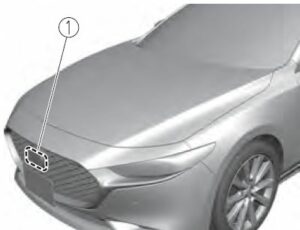
- Front side radar sensor
The front side radar sensors are installed inside the front bumper, one on each side. Always keep the surface of the front bumper near the front side radar sensors clean so that they operate normally. Also, do not apply items such as stickers. Refer to Exterior Care
CAUTION
If the front bumper receives a severe impact, the system may no longer operate normally. Stop the system immediately and have the vehicle inspected at an Authorized Mazda Dealer.
NOTE
- The detection ability of the front-side radar sensor has limitations. In the following cases, the detection ability may lower and the system may not operate normally. The front bumper near the front side radar sensor has become deformed. Snow, ice or mud adheres to the front side radar sensor on the front bumper. Under bad weather conditions such as rain, snow, and fog. Under the following conditions, the front-side radar sensor cannot detect target objects or it may be difficult to detect them. Small motorcycles, bicycles, pedestrians, animals, shopping carts, and stationary objects on a road or a roadside. Vehicle shapes that do not reflect radar waves well such as empty trailers with a low vehicle height and sports cars.
- Vehicles are shipped with the direction of the front side radar sensor adjusted for each vehicle to a loaded vehicle condition so that the front side radar sensor detects approaching vehicles correctly. If the direction of the front side radar sensor has deviated for some reason, have the vehicle inspected at an Authorized Mazda Dealer. For repairs or replacement of the front side radar sensor, or bumper repairs, paintwork, and replacement near the radar sensors, consult an Authorized Mazda Dealer.
- The radar sensors are regulated by the relevant radio wave laws of the country in which the vehicle is driven. If the vehicle is driven abroad, authorization from the country in which the vehicle is driven may be required.
Rear Side Radar Sensor
Rear Side Radar Sensor Your vehicle is equipped with a rear-side radar sensor. The following systems also use the rear-side radar sensor.
- Blind Spot Monitoring (BSM) Rear Cross Traffic Alert (RCTA) Smart Brake Support (SBS) reverse drive detection
The rear side radar sensors emit radio waves and detect the radio waves reflected off a vehicle approaching from the rear or an obstruction.
4–Door  Rear side radar sensor
Rear side radar sensor
5–Door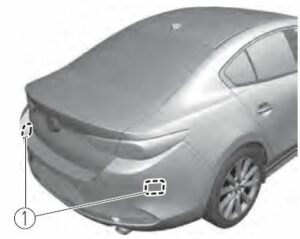 Rear side radar sensor
Rear side radar sensor
The rear side radar sensors are installed inside the rear bumper, one on each side. Always keep the surface of the rear bumper near the rear side radar sensors clean so that they operate normally. Also, do not apply items such as stickers.
CAUTION
If the rear bumper receives a severe impact, the system may no longer operate normally. Stop the system immediately and have the vehicle inspected at an Authorized Mazda Dealer.
NOTE
- The detection ability of the rear side radar sensor has limitations. In the following cases, the detection ability may lower and the system may not operate normally. The rear bumper near the rear side radar sensor has become deformed. Snow, ice or mud adheres to the rear side radar sensor on the rear bumper. Under bad weather conditions such as rain, snow and fog. Under the following conditions, the rear side radar sensor cannot detect target objects or it may be difficult to detect them. Small motorcycles, bicycles, pedestrians, animals, shopping carts, and stationary objects on a road or a roadside. Vehicle shapes that do not reflect radar waves well such as empty trailers with a low vehicle height and sports cars.
- Vehicles are shipped with the direction of the rear side radar sensor adjusted for each vehicle to a loaded vehicle condition so that the rear side radar sensor detects approaching vehicles correctly. If the direction of the rear side radar sensor has deviated for some reason, have the vehicle inspected at an Authorized Mazda Dealer.
- For repairs or replacement of the rear side radar sensor, bumper repairs, paintwork, and replacement near the radar sensors, consult an Authorized Mazda Dealer. The radar sensors are regulated by the relevant radio wave laws of the country in which the vehicle is driven. If the vehicle is driven abroad, authorization from the country in which the vehicle is driven may be required.
Rear/Rear Corner Ultrasonic Sensor*
Rear/Rear Corner Ultrasonic Sensor
The ultrasonic sensors function by emitting ultrasonic waves which are reflected off obstructions at the rear and the returning ultrasonic waves are picked up by the ultrasonic sensors.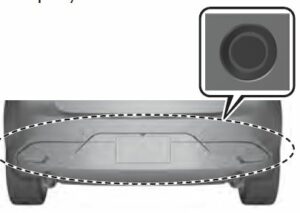 The ultrasonic sensors are mounted in the rear bumper.
The ultrasonic sensors are mounted in the rear bumper.
Front Camera/Side Cameras/Rear Camera*
Front Camera/Side Cameras/Rear Camera Your vehicle is equipped with a front camera, side cameras, and a rear camera. The 360° View Monitor uses each camera. Refer to 360° View Monitor The front camera, side cameras, and rear camera shoot images of the area surrounding the vehicle. Each camera is installed to the following positions.
- Side cameras
- Front camera
- Rear camera
5–Door
- Side cameras
- Front camera
- Rear camera
Driver Monitoring Camera
Driver Monitoring Camera The driver monitoring camera detects changes in the driver’s facial features and estimates the amount of accumulated fatigue and sleepiness of the driver. 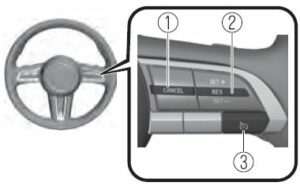 Driver monitoring camera NOTE
Driver monitoring camera NOTE
- Driver Monitoring (DM) and the earlier collision warning may not operate normally under the following conditions. The driver monitoring camera is covered with something. You are driving the vehicle while leaning on the steering wheel. You are wearing glasses or sunglasses. A cap or hat you are wearing partially blocks the driver monitoring camera’s view of your eyes, you have long bangs partially covering your eyes, or a part of your face is invisible due to a face mask. The lighting conditions change significantly (such as backlight, light from the side, or direct light from the setting sun, and the headlights of on-coming vehicles).
- You are driving the vehicle with your head excessively tilted to one side or the other. You are moving around extensively. Your face or your eyes frequently turn in direction other than straight ahead (direction of travel). Your line of sight moves or directly after it has moved. There is a large difference between your line of sight and the direction your face is pointed. You are driving the vehicle with your head largely tilted to one side. Free/open source software information This product includes free/open sources. Information about the licensing and source code is available at the following URL. http://www.embedded-carmultimedia.jp/RTOS/License/oss/DMS_0201/
Cruise Control
Cruise Control
With cruise control, you can set and automatically maintain any speed of more than about 30 km/h (19 mph).
WARNING
Do not use the cruise control under the following conditions:
Using the cruise control under the following conditions is dangerous and could result in loss of vehicle control.
- Hilly terrain Steep inclines Heavy or unsteady traffic Slippery or winding roads Similar restrictions that require inconsistent speed The vehicle speed may exceed the set speed during sudden acceleration or on steep down slopes. In this case, depress the brake pedal to adjust the vehicle speed.
Cruise Control Switch
- CANCEL switch
- RES switch
- Cruise switch
NOTE If your Mazda has the following steering switch, your Mazda is equipped with the Mazda Radar Cruise Control (MRCC) system, the Mazda Radar Cruise Control with Stop & Go function (MRCC with Stop & Go function) system.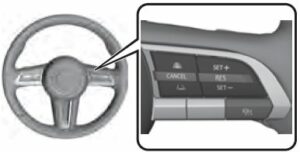 Refer to Mazda Radar Cruise Control (MRCC) Refer to Mazda Radar Cruise Control with Stop & Go function (MRCC with Stop & Go function) on page 4-139. If the Mazda Radar Cruise Control (MRCC) or Mazda Radar Cruise Control with Stop & Go function (MRCC with Stop & Go function) is set to inoperable using the personalization feature, the system switches to the cruise control function. In this case, the MRCC functions as the cruise switch. In addition, this personalization feature setting is initialized by switching the ignition OFF, and it turns back on when the ignition is switched ON the next time.
Refer to Mazda Radar Cruise Control (MRCC) Refer to Mazda Radar Cruise Control with Stop & Go function (MRCC with Stop & Go function) on page 4-139. If the Mazda Radar Cruise Control (MRCC) or Mazda Radar Cruise Control with Stop & Go function (MRCC with Stop & Go function) is set to inoperable using the personalization feature, the system switches to the cruise control function. In this case, the MRCC functions as the cruise switch. In addition, this personalization feature setting is initialized by switching the ignition OFF, and it turns back on when the ignition is switched ON the next time.
Cruise Standby Indication
(White)/Cruise Set Indication (Green)
Cruise standby Indication (White)
The indication turns on (white) when the cruise control system is activated.
Cruise Set Indication (Green)
The indication turns on (green) when a cruising speed has been set.  Activation/Deactivation
Activation/Deactivation
WARNING
Always turn off the cruise control system when it is not in use: Leaving the cruise control system in an activation-ready state while the cruise control is not in use is dangerous as the cruise control could unexpectedly activate if the activation button is accidentally pressed, and result in loss of vehicle control and an accident. If the headway control function is disabled using a Mazda Connect setting, the system switches to cruise control.
Activation
To activate the system, press the cruise switch. The cruise standby indication (white) turns on.
Deactivation
To deactivate the system, press the cruise switch again. The cruise standby indication (white) turns off.
To Set Speed
- Activate the cruise control system by pressing the cruise switch. The cruise standby indication (white) turns on.
- Accelerate to the desired speed, which must be more than 25 km/h (16 mph).
- Adjust the system to the desired vehicle speed using the accelerator pedal. Press the RES switch up (SET+) or down (SET-) to start cruise control. The cruise control indication (green) in the instrument cluster turns on at the same time. Quickly release the switch when the cruise control indication (green) turns on.
NOTE
- If the RES switch is operated up (SET+) or down (SET-) while the vehicle speed is between 25 and 30 km/h (16 to 19 mph), the set speed is set to 30 km/h (19 mph). The cruise control speed setting cannot be performed under the following conditions: Any of the doors is opened. The driver’s seat belt is unfastened. The brake pedal is depressed.
- The parking brake is applied.
- (Automatic transmission) The selector lever is in the P, N, or R position. (Manual transmission) The shift lever is in the neutral position.
- On a steep grade, the vehicle may momentarily slow down while ascending or speed up while descending.
- The cruise control will cancel if the vehicle speed decreases below 20 km/h (12 mph) when the cruise control is activated, such as when climbing a steep grade.
The vehicle speed preset using the cruise control is displayed in the instrument cluster and the active driving display (vehicles with active driving display).
Instrument cluster (Basic display)  Instrument cluster (i-ACTIVSENSE display)
Instrument cluster (i-ACTIVSENSE display)  Active driving display
Active driving display
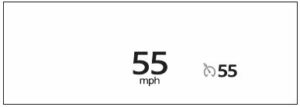
Changing the Set Vehicle Speed
Follow either of these procedures
To increase/decrease speed using the cruise control switch
When the RES switch is pressed up (SET+), the vehicle accelerates and when the RES switch is pressed down (SET-), it decelerates. Press and release immediately: 1 km/h (1 mph) Press and hold: 10 km/h (5 mph)
NOTE
Even after releasing the RES switch, the cruise control accelerates/decelerates continuously until the set speed displayed in the instrument cluster and on the active driving display is reached. If you want to stop accelerating/decelerating, change the set speed or cancel the system (such as by depressing the brake pedal)
To increase speed use the accelerator pedal
Depress the accelerator pedal and press the RES switch up (SET+) or down (SET-) at the desired speed. If the switch is not operated, the system returns to the set speed after you release your foot from the accelerator pedal.
NOTE
Accelerate if you want to speed up temporarily when the cruise control is on. Greater speed will not interfere with or change the set speed. Take your foot off the accelerator to return to the set speed. To Resume Cruising Speed at More Than 30 km/h (19 mph) If the cruise control system is temporarily cancelled (such as by applying the brake pedal) and the system is still activated, the most recent set speed will automatically resume when the RES switch is pressed. If vehicle speed is below 30 km/h (19 mph), increase the vehicle speed up to 30 km/h (19 mph) or more and press the RES switch.
To Temporarily Cancel
To temporarily cancel the system, use one of these methods:
- Slightly depress the brake pedal. Press the CANCEL switch.
- (Manual transmission) Depress the clutch pedal.
If the RES switch is pressed when the vehicle speed is 30 km/h (19 mph) or higher, the system reverts to the previously set speed.
NOTE
- If any of the following conditions occur, the cruise control system is temporarily cancelled. Even when the brake pedal is slightly depressed. The DSC is operating. There is a problem in the system. Any of the doors is opened. The driver’s seat belt is unfastened. The parking brake is applied. (Automatic transmission) The selector lever is in the P, N, or R position.
- (Manual transmission)
The shift lever is in the neutral position. - When the cruise control system is temporarily cancelled by even one of the applicable cancel conditions, the speed cannot be reset.
- (Automatic transmission)
The cruise control cannot be cancelled while driving in manual mode (selector lever shifted from D to M position). Therefore, engine braking will not be applied even if the transmission is shifted down to a lower gear. If deceleration is required, lower the set speed or depress the brake pedal.
To Deactivate
Press the cruise switch again.
Tire Pressure Monitoring System (TPMS)
Tire Pressure Monitoring System (TPMS)
The TPMS monitors the air pressure of each tire and if it decreases below the specified value, the system notifies the driver by turning on the TPMS warning light in the instrument cluster and indicating a message on the multi-information display. For the TPMS, the air pressure data sent from the tire pressure sensors installed on each wheel via radio signal is received by the receiver unit in the vehicle to monitor the tire pressures. 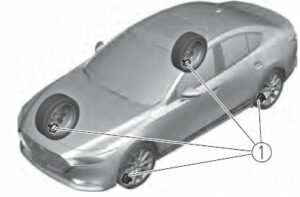 Tire pressure sensors In addition, the current tire pressures can be checked using the centre display. Refer to the Vehicle Status Monitor section in the Mazda Connect Owner’s Manual. NOTE
Tire pressure sensors In addition, the current tire pressures can be checked using the centre display. Refer to the Vehicle Status Monitor section in the Mazda Connect Owner’s Manual. NOTE
- When the ambient temperature is low, the tire temperatures also decrease. If the tire temperatures decrease, the air pressure in the tires will also decrease which could turn on the TPMS warning light.
- Before driving, visually inspect the tires for abnormalities. Additionally, inspect the tire pressures monthly. A digital-type air pressure gauge is recommended for inspecting the tire pressures.
The TPMS is not a substitute for your own periodic inspection of the tires. Always inspect the tires yourself periodically.
CAUTION
- Each tire, including the spare (if provided), should be checked monthly when cold and inflated to the inflation pressure recommended by the vehicle manufacturer on the vehicle placard or tire inflation pressure label. (If your vehicle has tires of a different size than the size indicated on the vehicle placard or tire inflation pressure label, you should determine the proper tire inflation pressure for those tires.) As an added safety feature, your vehicle has been equipped with a tire pressure monitoring system (TPMS) that illuminates a low tire pressure telltale when one or more of your tires is significantly under-inflated. Accordingly, when the low tire pressure telltale illuminates, you should stop and check your tires as soon as possible, and inflate them to the proper pressure. Driving on a significantly under-inflated tire causes the tire to overheat and can lead to tire failure. Under-inflation also reduces fuel efficiency and tire tread life, and may affect the vehicle’s handling and stopping ability.
- Please note that the TPMS is not a substitute for proper tire maintenance, and it is the driver’s responsibility to maintain correct tire pressure, even if under-inflation has not reached the level to trigger illumination of the TPMS low tire pressure telltale. Your vehicle has also been equipped with a TPMS malfunction indicator to indicate when the system is not operating properly. The TPMS malfunction indicator is combined with the low tire pressure telltale. When the system detects a malfunction, the telltale will flash for approximately one minute and then remain continuously illuminated. This sequence will continue upon subsequent vehicle start-ups as long as the malfunction exists. When the malfunction indicator is illuminated, the system may not be able to detect or signal low tire pressure as intended. TPMS malfunctions may occur for a variety of reasons, including the installation of replacement or alternate tires or wheels on the vehicle that prevent the TPMS from functioning properly. Always check the TPMS malfunction telltale after replacing one or more tires or wheels on your vehicle to ensure that the replacement or alternate tires and wheels allow the TPMS to continue to function properly.
- To avoid false readings, the system samples for a little while before indicating a problem. As a result it will not instantaneously register a rapid tire deflation or blow out.
If there is a problem with the Tire Pressure Monitoring System (TPMS)
If the TPMS warning light flashes, there may be a problem with the system. Consult an Authorized Mazda Dealer to have the system inspected. Refer to Tire Pressure Monitoring System (TPMS) Warning Indication/Warning Light (Flashing) In the following cases, the system cannot recognize the tire pressures correctly and the TPMS warning light may flash.
- There is equipment or a device nearby emitting radio signals the same as a tire pressure sensor. A metallic object such as a non-genuine electronic device is installed near the center of the dashboard (obstructs the radio signals from the tire pressure sensors to the receiver). A device such as one of the following is used in the cabin. Electronic devices such as a computer. Converter devices such as a DC-AC converter. There is a large accumulation of snow or ice around the vehicle tires. The battery in a tire pressure sensor is dead. A wheel not equipped with a tire pressure sensor is used. Tires employing steel in the sidewall of the tire are installed. Tire chains are used.
When a tire pressure decreases
If the TPMS warning light turns on, a tire pressure may be low. Inspect the tire pressures and adjust them to the correct inflation pressure. Refer to Tire Pressure Monitoring System (TPMS) Warning Indication/Warning Light (Turns on)
Tires and Wheels
CAUTION
When inspecting/adjusting the tire pressures, do not apply excessive force to the air valve of the tire pressure sensor. Otherwise, the tire pressure sensor could be damaged. When changing tires and wheels When changing the tires or wheels (such as installing winter tires), it will be necessary to register the ID signal code of the tire pressure sensor to the TPMS. Have an Authorized Mazda Dealer do the registration or register the ID signal codes of the tire pressure sensors using the following procedure.
NOTE
The tire pressure sensors on each wheel have a unique ID signal code. For the TPMS to operate correctly, the ID signal codes of the tire pressure sensors need to be registered to the system.
- Wait more than 19 minutes after changing a tire or wheel.
- After more than 19 minutes have passed, drive the vehicle at a speed of about 25 km/h (16 mph) or faster for 3 minutes or longer. While driving, the ID signal codes of the tire pressure sensors are automatically registered.
NOTE
If you drive the vehicle within 19 minutes of changing a tire or wheel, the TPMS warning light will flash because the ID signal codes for the tire pressure sensors were not registered. In this case, stop the vehicle and register the ID signal codes of the tire pressure sensors following the procedure. When replacing tires and wheels.
CAUTION
When replacing the tires and wheels, consult an Authorized Mazda Dealer Otherwise, the tire pressure sensors could be damaged when replacing them. Do not install non-genuine wheels. If wheels other than genuine ones are installed, it may not be possible to install the tire pressure sensors. When replacing a tire or wheel, always install the tire pressure sensor. The following combinations of tires, wheels, or tires and wheels are possible.
- The tire pressure sensor from the old wheel is removed and it is installed to the new wheel. Only a tire is replaced without replacing the tire pressure sensor and wheel. A new tire pressure sensor is installed to a new wheel.
NOTE
When installing a new tire pressure sensor, the ID signal code for the tire pressure sensor needs to be registered. For details on purchasing a tire pressure sensor and registering the ID signal of the tire pressure sensor, consult an Authorized Mazda Dealer.
Rear View Monitor
The rear view monitor provides visual images of the rear of the vehicle when reversing.
WARNING
Always drive carefully confirming the safety of the rear and the surrounding conditions by looking directly with your eyes:
Reversing the vehicle by only looking at the screen is dangerous as it may cause an accident or a collision with an object. The rear view monitor is only a visual assist device when reversing the vehicle. The images on the screen may be different from the actual conditions.
CAUTION
- Do not use the rearview monitor under the following conditions: Using the rearview monitor under the following conditions is dangerous and could result in injury or vehicle damage or both.
- Icy or snow-covered roads.
- Tire chains or a temporary spare tire is installed.
- The vehicle is on a road incline.
- Bumpy roads.
- When the display is cold, images may course across the monitor or the screen and maybe dimmer than usual, which could cause difficulty in confirming the surrounding conditions of the vehicle. Always drive carefully confirming the safety of the rear and the surrounding conditions by looking directly with your eyes.
- Do not apply excessive force to the camera. The camera position and angle may deviate.
- Do not disassemble, modify, or remove it as it may no longer be waterproof.
- The camera cover is made of plastic. Do not apply degreasing agents, organic solvents, wax, or glass coating agents to the camera cover. If any are spilt on the cover, wipe off with a soft cloth immediately.
- Do not rub the camera cover forcefully with an abrasive or hard brush. The camera cover or lens may be scratched which might affect the images.
- If a camera lens is severely damaged by flying gravel, have the camera replaced? For camera replacement, consult an Authorized Mazda Dealer.
NOTE
- If water, snow, or mud is stuck on the camera lens, wipe it off using a soft cloth. If it cannot be wiped off, use a mild detergent.
- If the camera temperature changes rapidly (Hot to cold, cold to hot), the rear view monitor may not operate correctly.
- When replacing the tires, consult an Authorized Mazda Dealer. Replacing the tires could result in deviation of the guide lines which appear on the display.
- If the vehicle’s front, side, or rear has been involved in a collision, the alignment of the rear view parking camera (location, installation angle) may have deviated. Always consult an Authorized Mazda Dealer to have the vehicle inspected.
- If “No camera signal.” is indicated in the display, there could be a problem with the camera. Have your vehicle inspected at an Authorized Mazda Dealer.
- (Predicted vehicle path assist lines display type) If force is applied to the steering wheel, the guide lines may not display. Loosen your grip on the steering wheel to allow the guide lines to display.
Rear View Parking Camera Location 4–Door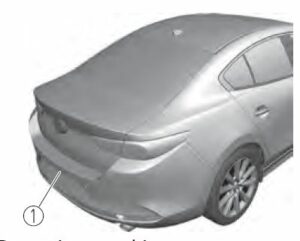
- Rear view parking camera
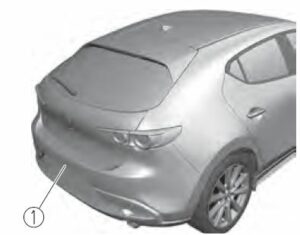
- Rear view parking camera
Switching to the Rear View Monitor Display
Shift the shift lever (manual transmission) or the selector lever (automatic transmission) to reverse (R) position with the ignition switched ON to switch the display to the rear view monitor display.
NOTE
When the shift lever (manual transmission) or the selector lever (automatic transmission) is shifted from reverse (R) position to another shift lever (manual transmission) or the selector lever (automatic transmission) position, the screen returns to the previous display.
Displayable Range on the Screen
The images on the screen may be different from the actual conditions.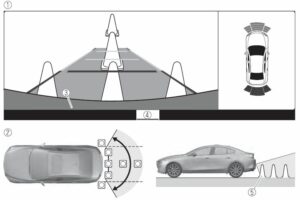
- (Screen display)
- (Actual view)
- Bumper
- “Check surroundings for safety.” message is displayed
- Object
NOTE
- The displayable range varies depending on the vehicle and road conditions.
- If the camera lens is touched or there is any dirt on it, it could affect the screen image. Wipe the lens using a soft cloth.
- The displayable range is limited. Objects under the bumper or around the bumper ends cannot be displayed.
- The distance appearing in the displayed image is different from the actual distance because the rear view parking camera is equipped with a specific lens.
- Images displayed on the monitor from the rear view parking camera are reversed images (mirror images).
- Some optionally installed vehicle accessories may be picked up by the camera. Do not install any optional parts that can interfere with the camera view, such as illuminating parts or parts made of reflective material.
- It may be difficult to see the display under the following conditions, however, it does not indicate a malfunction.
- In darkened areas.
- When the temperature around the lens is high/low.
- When the camera is wet such as on a rainy day or during periods of high humidity.
- When foreign material such as mud is stuck around the camera.
- When the camera lens reflects sunlight or headlight beams.
- The surroundings are illuminated by vehicle lights, fluorescent lights, or LED lights (display may flicker).
- Extremely small dark or white dots appear on the screen (dots may flicker).
- An object is close to a camera.
- Image display may be delayed if the temperature around the camera is low.
Viewing the Display Predicted vehicle path assist lines display type The projected path guidance mode displays the predicted path of the vehicle after you turn the steering wheel. Use this mode for parking your vehicle in a parking space or garage.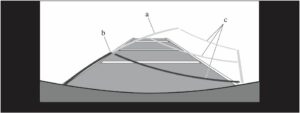
- Projected vehicle path (yellow) These lines are displayed as a reference for the projected path of the vehicle. The lines displaying the projected vehicle path change after you turn the steering wheel.
- Extended vehicle width lines (blue) These lines indicate the vehicle’s extended width. These lines are not displayed when the vehicle’s wheels are in the straight-ahead position.
- Distance guide lines (red)
- These lines indicate the approximate distance to a point measured from the vehicle’s rear (from the end of the bumper). The blue line indicates the point about 0.5 m (19 in) from the rear bumper. The red and yellow lines, which change position after you turn the steering wheel, indicate the points about 0.5 m (19 in) for the red line and 1.0 m (39 in) and 2.0 m (78 in) for the yellow lines from the rear bumper (at the center point of each of the lines). A degree of error occurs when the wheels are not in the straight-ahead position. In the above illustration, the right side of the vehicle is in a position closer to the actual distance displayed by the distance guide lines (red: about 0.5 m (19 in) point, yellow: about 1.0 m (39 in), and yellow: about 2.0 m (78 in) point behind the rear bumper), whereas the left side is in a position farther away.
CAUTION
The indicated position of the guide lines on the display changes depending on the vehicle conditions (such as the number of occupants/cargo load) and the road conditions (such as a steep gradient to the rear of the vehicle). Always check the area to the vehicle’s rear and the surrounding area directly with your eyes while backing up.
Fixed assist lines display type
Guide lines which indicate the width of the vehicle are displayed on the screen as a reference to the approximate width of the vehicle in comparison to the width of the parking space you are about to back into. Use this display view for parking your vehicle in a parking space or garage. 
- Vehicle width guide lines Guide lines serve as a reference to the approximate width of the vehicle.
- Distance guide lines These guide lines indicate the approximate distance to a point measured from the vehicle’s rear (from the end of the bumper). The red line indicates the point about 0.5 m (19 in) from the rear bumper.
- The yellow lines indicate the points about 1.0 m (39 in) and 2.0 m (78 in) from the rear bumper.
CAUTION
The guide lines on the screen are fixed lines. They are not synced to the driver’s turning of the steering wheel. Always be careful and check the area to the vehicle’s rear and the surrounding area directly with your eyes while backing up.
Rear View Monitor Operation
The operation of the rear view monitor when reversing the vehicle varies depending on the traffic, road, and vehicle conditions. The amount of steering and the timing also varies depending on conditions, so confirm the surrounding conditions directly with your eyes and steer the vehicle in accordance with the conditions. Be well aware of the above cautions prior to using the rear view monitor. Predicted vehicle path assist lines display type
NOTE
The following shows an example of vehicle parking in which the steering wheel is turned to the right when backing up the vehicle. The operation is reversed when backing up the vehicle from the opposite direction.
- Shift the shift lever (manual transmission) or the selector lever (automatic transmission) to reverse (R) position to switch the display to the rear view monitor display.
- Before backing the vehicle into the parking space, turn the steering wheel while referring to the projected vehicle path display so that the vehicle enters the center of the parking space.

- (Display condition)
- (Vehicle condition)
- Continue to adjust the steering wheel until the vehicle width guide lines are parallel to the left and right sides of the parking space.
- Once they are parallel, straighten the wheels and back your vehicle slowly into the parking space. Continue checking the vehicle’s surroundings and then stop the vehicle in the best possible position. (If the parking space has division lines, check whether the vehicle width guide lines are parallel to them.)

- (Display condition)
- (Vehicle condition)
- When the shift lever (manual transmission) or the selector lever (automatic transmission) is shifted from reverse (R) position to another shift lever (manual transmission) or the selector lever (automatic transmission) position, the screen returns to the previous display.
NOTE Because there may be a difference between the displayed image, such as indicated below, and the actual conditions when parking, always verify the safety at the rear of the vehicle and the surrounding area directly with your eyes.
- In the image of the parking space (or garage) displayed on the screen, the back end and distance guide lines may appear aligned in the monitor, but they may not actually be aligned on the ground.
When parking in a space with a division line on only one side of the parking space, the division line and the vehicle width guide line appear aligned in the monitor, but they may not actually be aligned on the ground. 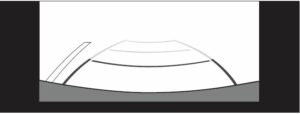 Fixed assist lines display type
Fixed assist lines display type
- NOTE
Images displayed on the monitor from the rear view parking camera are reversed images (mirror images).
- Shift the shift lever (manual transmission) or the selector lever (automatic transmission) to reverse (R) position to switch the display to the rear view monitor display.
- Confirming the surrounding conditions, reverse the vehicle.
- After your vehicle begins entering the parking space, continue backing up slowly so that the distance between the vehicle width lines and the sides of the parking space on the left and right are roughly equal.
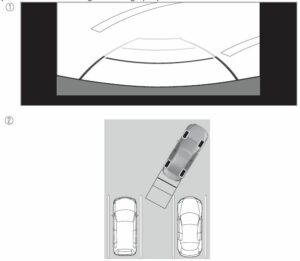
- (Display condition)
- (Vehicle condition)
- Continue to adjust the steering wheel until the vehicle width guide lines are parallel to the left and right sides of the parking space.
- Once they are parallel, straighten the wheels and back your vehicle slowly into the parking space. Continue checking the vehicle’s surroundings and then stop the vehicle in the best possible position. (If the parking space has division lines, check whether the vehicle width guide lines are parallel to them.)
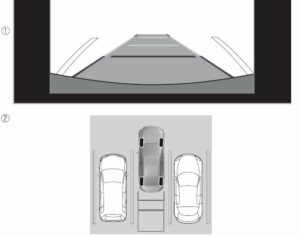
- (Display condition)
- (Vehicle condition)
- When the shift lever (manual transmission) or the selector lever (automatic transmission) is shifted from reverse (R) position to another shift lever (manual transmission) or the selector lever (automatic transmission) position, the screen returns to the previous display.
NOTE
Because there may be a difference between the displayed image, such as indicated below, and the actual conditions when parking, always verify the safety at the rear of the vehicle and the surrounding area directly with your eyes.
- In the image of the parking space (or garage) displayed on the screen, the back end and distance guide lines may appear aligned in the monitor, but they may not actually be aligned on the ground.
- When parking in a space with a division line on only one side of the parking space, the division line and the vehicle width guide line appear aligned in the monitor, but they may not actually be aligned on the ground.
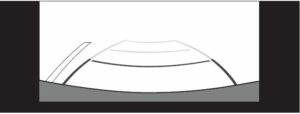 Variance Between Actual Road Conditions and Displayed Image
Variance Between Actual Road Conditions and Displayed Image - Some variance occurs between the actual road and the displayed road. Such variance in distance perspective could lead to an accident. Note the following conditions that may cause a variance in distance perspective. When the vehicle is tilted due to the weight of passengers and load When the vehicle rear is lowered, the object displayed on the screen appears farther than the actual distance.

- Object
- Variance
- Object on screen
When there is a steep grade behind the vehicle
When there is a steep upgrade (downgrade) behind the vehicle, the object displayed on the screen appears farther (downgrade: closer) than the actual distance.
- Appears farther than actual distance
- Appears closer than actual distance
- Distance between the vehicle and object displayed on the screen.
- Actual distance between the vehicle and object.
- Object at actual position
- Object on screen
Three-dimensional object on vehicle rear
Because the distance guide lines are displayed based on a flat surface, the distance to the three-dimensional object displayed on the screen is different from the actual distance.
- (Screen display)
- (Actual condition)
- Sensed distance on screen A>B>C
- Actual distance B>C=A
(Predicted vehicle path assist lines display type)
When reversing near a three-dimensional object When reversing near an overhanging object, the vehicle may hit the object even if the anticipated course line does not contact the object on the screen. The position of the object displayed on the screen is different from the actual position because the anticipated course lines on the screen are displayed based on a horizontal road surface. When backing up near an overhanging object, confirm the rear and surrounding conditions directly with your eyes.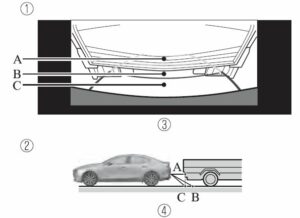
- (Screen display)
- (Actual view)
Parking Sensor System
The parking sensors use ultrasonic sensors which detect obstructions around the vehicle when the vehicle is driven at low speeds, such as during garage or parallel parking, and a buzzer sound and detection indicator notify the driver of the approximate distance from the vehicle to the surrounding obstruction.
WARNING
Do not rely completely on the parking sensor system and be sure to confirm the safety around your vehicle visually when driving: This system can assist the driver in operating the vehicle in the forward and backward directions while parking. The detection ranges of the sensors are limited, therefore, driving the vehicle while relying only on the system may cause an accident. Always confirm the safety around your vehicle visually when driving.
CAUTION
- Do not install any accessories within the detection ranges of the sensors. It may affect the system operation.
- Depending on the type of obstruction and the surrounding conditions, the detection range of a sensor may narrow, or the sensors may not be able to detect obstructions.
- When washing the vehicle, do not spray highly pressurized water against the sensor area, or rub it strongly. Otherwise, it may not be able to detect obstructions correctly and the system may not operate normally.
NOTE
- When the ignition is switched OFF, the system status before it was turned off is maintained. For example, if the ignition is switched OFF while the parking sensor is activated, the system will be activated when the ignition is switched ON the next time.
- The system may not operate normally under the following conditions:
- Mud, ice, or snow is adhering to the sensor area (Returns to normal operation when removed).
- The sensor area is frozen (Returns to normal operation when the ice is thawed).
- The sensor is covered by a hand.
- The sensor is excessively shocked.
- The vehicle is excessively tilted.
- Under extremely hot or cold weather conditions.
- The vehicle is driven on bumps, inclines, gravel, grating, or grass-covered roads.
- Anything which generates ultrasonic waves such as another vehicle’s horn, the engine sound of a motorcycle, the air brake sound of a large-sized vehicle, or another vehicle’s sensors approaches the vehicle.
- The vehicle is driven in heavy rain or in road conditions causing water splash.
- A commercially-available fender pole or an antenna for a radio transmitter is installed to the vehicle.
- The vehicle is moving towards a tall or square curbstone or a steep grade.
- An obstruction is too close to the sensor.
- The vehicle is moving towards an uneven wall or stairs.
- There are multiple obstructions.
- The vehicle is driven in a place with low ceilings.
- Obstructions under the bumper cannot be detected. Obstructions that are lower than the sensor or thin may not be detected even though they were detected once.
- The following types of obstructions may not be detected:
- Thin objects such as wire, rope or poles
- Things that absorb sonic waves easily such as cotton or snow
- Angular shaped objects
- Very tall objects, and those which are wide at the top
- Small, short objects
- Always have the system inspected at an Authorized Mazda Dealer if any shock is applied to the bumpers, even in a minor accident. If the sensors are deviated, they cannot detect obstructions.
- The system may malfunction if a sound is not activated or the detection indication is not displayed even when the parking sensor OFF switch is pressed and the parking sensor is operable. Have your vehicle inspected by an Authorized Mazda Dealer.
- The system may malfunction if the indicator light does not turn on even when the parking sensor OFF switch is turned on. Have your vehicle inspected by an Authorized Mazda Dealer.
- The system may malfunction if a message indicating a system malfunction is displayed. Have your vehicle inspected by an Authorized Mazda Dealer.
- A message may be displayed even when the ambient temperature is extremely cold, or mud, ice, or snow adheres to the sensor area. Remove any foreign matter from the sensor area.
- When installing a trailer hitch, consult an Authorized Mazda Dealer.
- If a Mazda genuine trailer hitch is used, the rear side of the parking sensor system is automatically turned off.
Sensor installation positions Front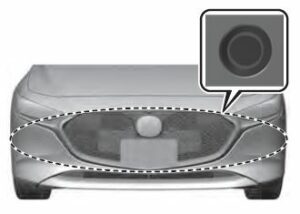 Rear
Rear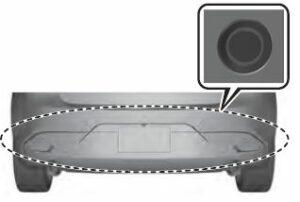 Sensor Detection Range
Sensor Detection Range
The sensors detect obstructions within the following range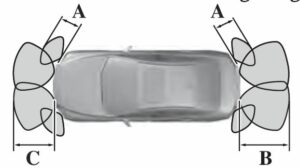
- About 55.0 cm (About 21.6 in)
- About 150 cm (About 59.0 in)
- About 100 cm (About 39.3 in)
Parking Sensor OFF Switch
When the switch is pressed, the parking sensor is stopped and the indicator light turns on. If the switch is pressed again, the parking sensor becomes operational and the indicator light turns off. 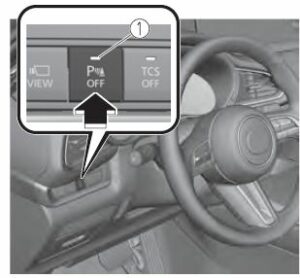
- Indicator light
Sound and viewing distance display
Informs the driver of the approximate distance from the vehicle to the obstruction using warning beeps depending on the distance. If multiple obstructions are detected at the same time, warning beeps are activated according to the distance to the nearest obstruction.
Front*, Rear
| Display | Beeper sound | |||
| Front | Rear | Without 360° view monitor | With 360° view monitor | |
Approx. 100―60.0 cm (39.3―23.6 in)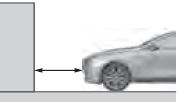 |
Approx. 150―60.0 cm (59.0―23.6 in)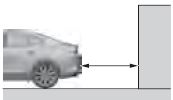 |
 |
Green  |
Slow intermittent sound |
| Distance between vehicle and obstruction | Display | Beeper sound | ||
| Front | Rear | Without 360° view monitor | With 360° view monitor | |
Approx. 60.0―45.0 cm (23.6―17.7 in) |
Approx. 60.0―45.0 cm (23.6―17.7 in) |
 |
Yellow |
Medium intermittent sound |
Approx. 45.0―35.0 cm (17.7―13.7 in)  |
Approx. 45.0―35.0 cm (17.7―13.7 in)  |
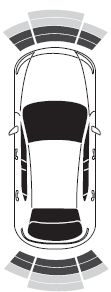 |
Amber 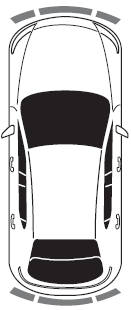 |
Fast intermittent sound |
Within approx. 35.0 cm (13.7 in)  |
Within approx. 35.0 cm (13.7 in) 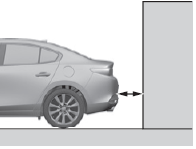 |
 |
Red |
Continuous sound |
Corner
| Distance between vehicle and obstruction | Display | Beeper sound | |
| Without 360° view monitor | With 360° view monitor | ||
Approx. 55.0―38.0 cm (21.6―14.9 in)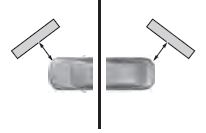 |
 |
Yellow 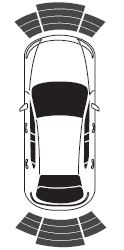 |
Medium intermittent sound |
Approx. 38.0―25 cm (14.9―9.8 in)  |
 |
Amber  |
Fast intermittent sound |
Within approx. 25 cm (9.8 in)  |
 |
Red  |
Continuous sound |
NOTE
- The detection indicator can be switched between display and non-display and the buzzer volume can be changed. Refer to the Settings section in the Mazda Connect Owner’s Manual.
- (Vehicles with 360° View Monitor) When the detection indicator is set to “Display”, even with the 360° view monitor not displayed, if a front sensor or a front corner sensor detects an obstruction, the 360° view monitor switches automatically to display. When an obstruction is no longer detected, the display switches to the display before the obstruction is detected. However, while the 360° view monitor is displayed, it continues to display no matter if an obstruction is detected or not.
- If an obstruction in the same area excluding the close area is detected continuously for 6 seconds or longer, only the warning beeps stop activating. (Detection is indicated) If the detection area changes to the closed side, the warning beeps resume. (If the detection area changes to the far side, the warning beeps remain off)
System Problem Indication
If any of the problems indicated in the table occurs, the driver is notified of the problem depending on the type of system as shown.
| Detection Indicator | Solution | ||
| Without 360° view monitor | With 360° view monitor | ||
 |
 |
The system may | |
| have a mal- | |||
| Sys- | function. Have | ||
| tem | the vehicle in- | ||
| mal- | spected at an | ||
| func- | Authorized | ||
| tion | Mazda Dealer | ||
| as soon as pos- | |||
| sible. | |||
The driver is notified of a problem with the following indications.
FAQs
The Mazda 3 Hatchback 2023 has a feature called the forward sensing camera that employs cutting-edge imaging technology to recognize and keep an eye on the road ahead.
Providing safety features like lane departure warning, adaptive cruise control, automatic emergency braking, and traffic sign recognition is the major goal of the forward-sensing camera.
How does the forward sensing camera work?
The forward sensing camera analyzes the visual data it has acquired using a variety of sensors and algorithms. To help the driver and improve safety, it can recognize lane markings, traffic signs, and other vehicles on the road.
Yes, the Mazda 3 Hatchback 2023’s forward-sensing camera can identify pedestrians and help with pedestrian detection systems like automated emergency braking.
The forward sensing camera is made to function well in a variety of lighting situations, such as daylight, low light, and nighttime. Extreme weather or impediments, however, might impair its performance.
Yes, the majority of Mazda vehicles with forward-facing cameras have a switch to engage or disable the system, giving drivers the choice to decide whether to use its features.
The forward sensing camera often does not need routine maintenance. To ensure correct performance, the camera lens must be kept clean and free of dust, debris, and impediments.
Although the forward sensing camera and related safety equipment can significantly help with accident avoidance, they cannot ensure total accident avoidance. It’s crucial for drivers to always pay attention and be on the lookout for danger.
No, the forward sensing camera is just intended to support the driver and improve safety; it does not take the place of careful driving. Drivers should always stay concentrated and vigilant, prepared to respond to any unforeseen circumstances.
The performance of the forward-sensing camera may be restricted by elements like unfavorable weather (heavy rain, fog, snow), occlusions (dirt on the lens), and specific road conditions. It’s critical to understand these restrictions.
The forward sensing camera system may be upgradeable or get updates, depending on the software of the vehicle and manufacturer policies. For detailed information, it is advised to refer to the owner’s handbook or get in touch with a Mazda dealership.
The forward-sensing camera might be included in particular option packages or be available only in certain trims. It is important to visit the official Mazda website or speak with a Mazda dealer to find out which trims of the Mazda 3 Hatchback 2023 model come with this function.
2023 Mazda 3 Hatchback Specs, Price, Features, Mileage (Brochure)
Useful Links
View Full User Guide: Mazda 3 Hatchback 2023 User Manual| Auto User Guide
Download Link: Owner’s – Manuals, Guides, Maintenance Schedules | Mazda USA
Related Article
2023 Mazda 3 Hatchback Specs, Price, Features, Mileage (Brochure)
2023 Mazda 3 Specs, Price, Features, Mileage (Brochure)

